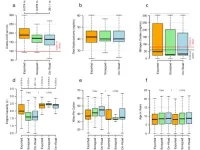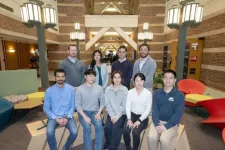(Press-News.org) The recent approval of a CRISPR-Cas9 therapy for sickle cell disease demonstrates that gene editing tools can do a superb job knocking out genes to cure hereditary disease. But it's still not possible to insert whole genes into the human genome to substitute for defective or deleterious genes.
A new technique that employs a retrotransposon from birds to insert genes into the genome holds more promise for gene therapy, since it inserts genes into a "safe harbor" in the human genome where the insertion won't disrupt essential genes or lead to cancer.
Retrotransposons, or retroelements, are pieces of DNA that, when transcribed to RNA, code for enzymes that copy RNA back into DNA in the genome — a self-serving cycle that clutters the genome with retrotransposon DNA. About 40% of the human genome is made up of this "selfish" new DNA, though most of the genes are disabled, so-called junk DNA.
The new technique, called Precise RNA-mediated INsertion of Transgenes, or PRINT, leverages the ability of some retrotransposons to efficiently insert entire genes into the genome without affecting other genome functions. PRINT would complement the recognized ability of CRISPR-Cas technology to disable genes, make point mutations and insert short segments of DNA.
A description of PRINT, which was developed in the laboratory of Kathleen Collins, a professor of molecular and cell biology at the University of California, Berkeley, will be published Feb. 20 in the journal Nature Biotechnology.
PRINT involves the insertion of new DNA into a cell using delivery methods similar to those used to ferry CRISPR-Cas9 into cells for genome editing. For PRINT, one piece of delivered RNA encodes a common retroelement protein called R2 protein, which has multiple active parts, including a nickase — an enzyme that binds and nicks double-stranded DNA — and reverse transcriptase, the enzyme that generates the DNA copy of RNA. The other RNA is the template for the transgene DNA to be inserted, plus gene expression control elements — an entire autonomous transgene cassette that R2 protein inserts into the genome, Collins said.
A key advantage of using R2 protein is that it inserts the transgene into an area of the genome that contains hundreds of identical copies of the same gene — each coding for ribosomal RNA, the RNA machine that translates messenger RNA (mRNA) into protein. With so many redundant copies, when the insertion disrupts one or a few ribosomal RNA genes, the loss of the genes won't be missed.
Putting the transgene into a safe harbor avoids a major problem encountered when inserting transgenes via a human virus vector, which is the common method today: The gene is often inserted randomly into the genome, disabling working genes or messing with the regulation or function of genes, potentially leading to cancer.
"A CRISPR-Cas9-based approach can fix a mutant nucleotide or insert a little patch of DNA — sequence fixing. Or you can just knock out a gene function by site-specific mutagenesis," said Collins, who holds the Walter and Ruth Schubert Family Chair. "We're not knocking out a gene function. We're not fixing an endogenous gene mutation. We're taking a complementary approach, which is to put into the genome an autonomously expressed gene that makes an active protein —to add back a functional gene as a deficit bypass. It's transgene supplementation instead of mutation reversal. To fix loss-of-function diseases that arise from a panoply of individual mutations of the same gene, this is great."
'The real winners were from birds'
Many hereditary diseases, such as cystic fibrosis and hemophilia, are caused by a number of different mutations in the same gene, all of which disable the gene's function. Any CRISPR-Cas9-based gene editing therapy would have to be tailored to a person's specific mutation. Gene supplementation using PRINT could instead deliver the correct gene to every person with the disease, allowing each patient’s body to make the normal protein, no matter what the original mutation.
Many academic labs and startups are investigating the use of transposons and retrotransposons to insert genes for gene therapy. One popular retrotransposon under study by biotech companies is LINE-1 (Long INterspersed Element-1), which in humans has duplicated itself and some hitchhiker genes to cover about 30% of the genome, though fewer than 100 of our genome’s LINE-1 retrotransposon copies are functional today, a miniscule fraction of the genome.
Collins, along with UC Berkeley postdoctoral colleague Akanksha Thawani and Eva Nogales, UC Berkeley Distinguished Professor in the Department of Molecular and Cell Biology and a Howard Hughes Medical Institute investigator, published a cryoelectron microscopy structure of the enzyme protein encoded by the LINE-1 retroelement on Dec. 14 in the journal Nature.
That study made it clear, Collins said, that the LINE-1 retrotransposon protein would be hard to engineer to safely and efficiently insert a transgene into the human genome. But previous research demonstrating that genes inserted into the repetitive, ribosomal RNA encoding region of the genome (the rDNA) get expressed normally suggested to Collins that a different retroelement, called R2, might work better for safe transgene insertion.
Because R2 is not found in humans, Collins and senior researcher Xiaozhu Zhang and postdoctoral fellow Briana Van Treeck, both from UC Berkeley, screened R2 from more than a score of animal genomes, from insects to the horseshoe crab and other multicellular eukaryotes, to find a version that was highly targeted to rDNA regions in the human genome and efficient at inserting long lengths of DNA into the region.
"After chasing dozens of them, the real winners were from birds," Collins said, including the zebra finch and the white-throated sparrow.
While mammals do not have R2 in their genomes, they do have the binding sites needed for R2 to effectively insert as a retroelement — likely a sign, she said, that the predecessors to mammals had an R2-like retroelement that somehow got kicked out of the mammalian genome.
In experiments, Zhang and Van Treeck synthesized mRNA-encoding R2 protein and a template RNA that would generate a transgene with a fluorescent protein expressed by an RNA polymerase promoter. These were cotransfected into cultured human cells. About half the cells lit up green or red due to fluorescent protein expression under laser light, demonstrating that the R2 system had successfully inserted a working fluorescent protein into the genome.
Further studies showed that the transgene did indeed insert into the rDNA regions of the genome and that about 10 copies of the RNA template could insert without disrupting the protein-manufacturing activity of the rDNA genes.
A giant ribosome biogenesis center
Inserting transgenes into rDNA regions of the genome is advantageous for reasons other than it gives them a safe harbor. The rDNA regions are found on the stubby arms of five separate chromosomes. All of these stubby arms huddle together to form a structure called the nucleolus, in which DNA is transcribed into ribosomal RNA, which then folds into the ribosomal machinery that makes proteins. Within the nucleolus, rDNA transcription is highly regulated, and the genes undergo quick repairs, since any rDNA breaks, if left to propagate, could shut down protein production. As a result, any transgene inserted into the rDNA region of the genome would be treated with kid gloves inside the nucleolus.
"The nucleolus is a giant ribosome biogenesis center," Collins said. "But it's also a really privileged DNA repair environment with low oncogenic risk from gene insertion. It's brilliant that these successful retroelements — I'm anthropomorphizing them — have gone into the ribosomal DNA. It's multicopy, it's conserved, and it's a safe harbor in the sense that you can disrupt one of these copies and the cell doesn't care."
This makes the region an ideal place to insert a gene for human gene therapy.
Collins admitted that a lot is still unknown about how R2 works and that questions remain about the biology of rDNA transcription: How many rDNA genes can be disrupted before the cell cares? Because some cells turn off many of the 400+ rDNA genes in the human genome, are these cells more susceptible to side effects of PRINT? She and her team are investigating these questions, but also tweaking the various proteins and RNAs involved in retroelement insertion to make PRINT work better in cultured cells and primary cells from human tissue.
The bottom line, though, is that "it works," she said. "It's just that we have to understand a little bit more about the biology of our rDNA in order to really take advantage of it."
Other co-authors of the Nature Biotechnology paper are UC Berkeley graduate students Connor Horton, Jeremy McIntyre, Sarah Palm and Justin Shumate. The work was supported by the National Institutes of Health (F32 GM139306, DP1 HL156819, T32 GM07232) and the Shurl and Kay Curci Foundation. Collins has filed for patents on PRINT, and co-founded a company, Addition Therapeutics, to develop PRINT further as a gene therapy.
END
Junk DNA in birds may hold key to safe, efficient gene therapy
Retrotransposons can insert new genes into a "safe harbor" in the genome, complementing CRISPR gene editing
2024-02-20
ELSE PRESS RELEASES FROM THIS DATE:
Fasting-like diet lowers risk factors for disease, reduces biological age in humans
2024-02-20
Cycles of a diet that mimics fasting can reduce signs of immune system aging, as well as insulin resistance and liver fat in humans, resulting in a lower biological age, according to a new USC Leonard Davis School of Gerontology-led study.
The study, which appears in Nature Communications on Feb. 20, adds to the body of evidence supporting the beneficial effects of the fasting-mimicking diet (FMD).
The FMD is a five-day diet high in unsaturated fats and low in overall calories, protein, and carbohydrates and is designed to mimic the effects ...
New model identifies drugs that shouldn’t be taken together
2024-02-20
CAMBRIDGE, MA -- Any drug that is taken orally must pass through the lining of the digestive tract. Transporter proteins found on cells that line the GI tract help with this process, but for many drugs, it’s unknown which of those transporters they use to exit the digestive tract.
Identifying the transporters used by specific drugs could help to improve patient treatment because if two drugs rely on the same transporter, they can interfere with each other and should not be prescribed together.
Researchers at MIT, Brigham and Women’s Hospital, and Duke University ...
Study shows UK offshores emissions through used vehicle exports
2024-02-20
Published today in Nature Climate Change, the study found that exported used vehicles generate at least 13-53% more emissions per mile than those that are scrapped or on the road in Great Britain. The researchers used mandatory annual vehicle inspections – known as MOT tests – of all 65 million used vehicles on British roads between 2005 and 2021 to compare the pollution and emissions intensity of vehicles exported to those scrapped, destroyed, or driven in Great Britain.
The data revealed substantially higher rates of carbon dioxide and pollution generation in exported vehicles. ...
Study: whether you exercise regularly or one-to-two days a week, weight loss is possible
2024-02-20
ROCKVILLE, Md.— Whether you engage in physical activity on a regular basis or one-to-two days a week, both options produce weight loss suggests a new study published in the journal Obesity, The Obesity Society’s (TOS) flagship journal. The study is the first of its kind to examine the association between physical activity patterns and objectively-measured fat tissue mass.
Guidelines from the World Health Organization recommend that adults perform at least 150 minutes per week of moderate physical activity, 75 minutes per week of vigorous physical activity or an equivalent combination of both intensities. ...
Health care inequities behind shorter life spans for Inuit from Nunavik, Quebec, with lung cancer
2024-02-20
People living in the Inuit region of Nunavik in northern Quebec die earlier after a diagnosis of lung cancer than Montreal residents receiving treatment at the same cancer centre, according to new research published in CMAJ (Canadian Medical Association Journal) https://www.cmaj.ca/lookup/doi/10.1503/cmaj.230682.
All inhabitants of Nunavik are investigated and treated for cancer at the McGill University Health Centre (MUHC) in Montreal, more than 1400 km away from Nunavik hospitals, due to limited resources in the region.
Researchers compared lung cancer survival ...
Anorexia nervosa can be life threatening in males
2024-02-20
Anorexia nervosa affects males as well as females, and affected males have a sixfold higher mortality rate than males in the general population. A new article published in CMAJ (Canadian Medical Association Journal) aims to raise awareness of this life-threatening eating disorder. https://www.cmaj.ca/lookup/doi/10.1503/cmaj.230001
"Early identification and prompt treatment are essential," writes Dr. Basil Kadoura, a specialist in adolescent health, British Columbia Children's Hospital and University of British Columbia, Vancouver, BC, with coauthors.
Five things to know about anorexia nervosa in males:
Up to 0.3% of males will be diagnosed with anorexia nervosa. ...
Researchers are using RNA in a new approach to fight HIV
2024-02-20
Society learned about the value of mRNA during the COVID-19 pandemic when we saw scientists and medical professionals harness its power to deliver a vaccine for the virus within a year.
Now, University of Waterloo pharmacy associate professor Emmanuel Ho has developed a novel nanomedicine loaded with genetic material called small interfering RNAs (siRNA) to fight human immunodeficiency virus (HIV) using gene therapy. These siRNAs regulate which genes or proteins are turned on or off in our cells and showed a 73 per cent reduction in HIV replication.
“This opens the door for new therapeutics in the fight against HIV,” ...
Remission of Cushing’s disease associated with higher risk of developing autoimmune disease
2024-02-19
Embargoed for release until 5:00 p.m. ET on Monday 19 February 2024
Annals of Internal Medicine Tip Sheet
@Annalsofim
Below please find summaries of new articles that will be published in the next issue of Annals of Internal Medicine. The summaries are not intended to substitute for the full articles as a source of information. This information is under strict embargo and by taking it into possession, media representatives are committing to the terms of the embargo not only on their own behalf, but also on behalf of the organization they represent.
----------------------------
Remission of ...
Stanford Medicine study identifies distinct brain organization patterns in women and men
2024-02-19
EMBARGOED FOR RELEASE UNTIL Monday, Feb. 19 at 12 p.m. Pacific time to coincide with the study’s publication in Proceedings of the National Academy of Sciences
Media contact: Erin Digitale at 650-724-9175 (digitale@stanford.edu)
A new study by Stanford Medicine investigators unveils a new artificial intelligence model that was more than 90% successful at determining whether scans of brain activity came from a woman or a man.
The findings, to be published Feb. 19 in the Proceedings of the National Academy of Sciences, help resolve a long-term controversy about whether reliable sex differences exist in the human ...
Chameleons inspire new multicolor 3D-printing technology
2024-02-19
THIS ARTICLE IS UNDER PNAS EMBARGO UNTIL MONDAY, FEB. 19 AT 3 PM US ET.
Inspired by the color-changing ability of chameleons, researchers developed a sustainable technique to 3D-print multiple, dynamic colors from a single ink.
“By designing new chemistries and printing processes, we can modulate structural color on the fly to produce color gradients not possible before,” said Ying Diao, an associate professor of chemistry and chemical and biomolecular engineering at the University of Illinois ...
LAST 30 PRESS RELEASES:
Researchers use robotics to find potential new antibiotic among hundreds of metal complexes
Gut bacteria changes at the earliest stages of inflammatory bowel disease
Scientists develop new way to “listen in” on the brain’s hidden language
Brain research: “Pulse generators” grow and shrink as memories are formed
For teens, any cannabis use may have impact on emotional health, academic performance
School meals could unlock major gains for human and planetary health
Menopause hormone therapy does not appear to impact dementia risk
Signature patterns of brain activity may help predict recovery from traumatic brain injury
Dresden study uncovers new key mechanism in cancer cells
New species are now being discovered faster than ever before, study suggests
Cannabis-based products show limited short-term benefit for chronic pain, with increased risk of adverse effects
Cannabis products with more THC slightly reduce pain but cause more side effects
Clearing the brain of aging cells could aid epilepsy and reduce seizures
Brain injuries linked with potential risk of suicide, new study finds
New technique lights up where drugs go in the body, cell by cell
New study finds movement of fishing fleets can reveal shifts in marine ecosystems
Embargoed: New evidence points to potential treatment for vascular dementia
Study uncovers disrupted brain balance in alcohol dependence
Working in groups can help Republicans and Democrats agree on controversial content moderation online
Structural findings reveal how distinct GPCR ligands create different levels of activation
Anything-goes “anyons” may be at the root of surprising quantum experiments
UC review: Maximizing workplace opportunity for veterans
From generation to complex control: Metasurfaces make perfect vortex beams "within reach"
Thin-film lithium niobate-based detector: recent advances and perspectives
Exploring why some people may tend to persistently make bad choices
How cells balance their protein levels
Nirsevimab vs RSVpreF vaccine for RSV–related hospitalization in newborns
Effectiveness and impact of maternal RSV immunization and nirsevimab on medically attended RSV in US children
AI gives scientists a boost, but at the cost of too many mediocre papers
Next-generation vision model maps tree growth at sub-meter precision
[Press-News.org] Junk DNA in birds may hold key to safe, efficient gene therapyRetrotransposons can insert new genes into a "safe harbor" in the genome, complementing CRISPR gene editing



